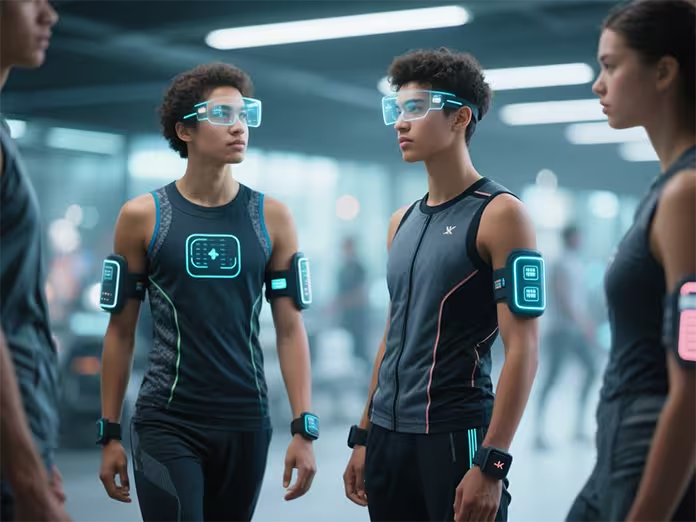
The fashion industry is experiencing a revolutionary transformation as technology seamlessly merges with style, creating an entirely new paradigm of wearable fashion tech trends. Gone are the days when clothing served merely aesthetic or protective purposes – today’s garments are becoming intelligent, interactive, and incredibly sophisticated pieces of technology disguised as fashion statements.
The Rise of Smart Textiles: Where Fabric Meets Silicon
The foundation of wearable fashion tech trends lies in smart textiles that respond to environmental changes, monitor health metrics, and even charge electronic devices. Companies like Google’s Project Jacquard have pioneered conductive threads woven directly into denim jackets, allowing users to control smartphones through simple gestures on their sleeves. These innovations represent just the beginning of a textile revolution that’s reshaping how we think about clothing.
Temperature-regulating fabrics are becoming increasingly sophisticated, with materials that automatically adjust to maintain optimal body temperature. Brands like Under Armour and Nike are incorporating phase-change materials that absorb, store, and release heat based on activity levels and environmental conditions. This technology isn’t just convenient – it’s becoming essential for athletes, outdoor enthusiasts, and anyone seeking maximum comfort throughout their day.
Health Monitoring: Your Clothes as Personal Healthcare Assistants
Perhaps the most compelling aspect of wearable fashion tech trends is the integration of health monitoring capabilities directly into everyday clothing. Smart shirts embedded with sensors can continuously monitor heart rate, breathing patterns, muscle activity, and even stress levels without the need for additional wearable devices.
Hexoskin and OMsignal have developed compression garments that provide medical-grade biometric monitoring while maintaining the comfort and style of premium activewear. These garments can detect irregular heartbeats, monitor sleep quality, and track fitness metrics with unprecedented accuracy. For individuals with chronic health conditions, these innovations represent a paradigm shift from reactive to proactive healthcare management.
The integration extends beyond fitness tracking to include posture correction systems built into smart clothing. These garments use subtle vibrations to remind wearers to maintain proper posture, potentially reducing back pain and improving overall physical wellbeing. As remote work continues to dominate professional landscapes, these health-focused wearable fashion tech trends are becoming increasingly relevant.
Sustainability Meets Innovation: Eco-Friendly Tech Fashion
Environmental consciousness is driving significant innovations in wearable fashion tech trends, with brands developing sustainable solutions that don’t compromise on technological advancement. Solar-powered clothing is emerging as a practical solution for charging small electronic devices, with flexible photovoltaic cells integrated into jackets, bags, and accessories.
Bolt Threads has revolutionized material science by creating leather alternatives from mushroom roots and synthetic spider silk, proving that sustainable materials can be both high-tech and luxurious. These bio-engineered materials often outperform traditional textiles in durability while maintaining biodegradability.
Self-cleaning fabrics represent another breakthrough in sustainable wearable technology. Using photocatalytic nanoparticles, these materials break down organic compounds and bacteria when exposed to light, reducing the need for frequent washing and extending garment lifespan. This technology is particularly valuable for outdoor gear and professional uniforms where cleanliness is crucial.
Augmented Reality Integration: Fashion Meets Virtual Worlds
The convergence of fashion and augmented reality (AR) is creating unprecedented opportunities for personal expression and functionality. Smart glasses integrated into stylish frames are becoming more mainstream, with companies like Ray-Ban partnering with Meta to create fashionable AR eyewear that seamlessly blends digital information with the physical world.
LED-embedded clothing allows for dynamic visual displays, enabling wearers to change patterns, colors, and even display messages through smartphone apps. These garments are particularly popular in entertainment, sports, and festival contexts where visual impact is paramount. Fashion designers are embracing programmable LEDs to create runway shows that were previously impossible.
Color-changing materials activated by temperature, UV exposure, or electrical signals are pushing the boundaries of personal style. These chameleon-like fabrics allow single garments to serve multiple aesthetic purposes, reducing the need for extensive wardrobes while maximizing creative expression.
Performance Enhancement: Athletic Wear Gets Smarter
Athletic and performance wear represents the most advanced frontier of wearable fashion tech trends. Compression garments with embedded sensors provide real-time feedback on muscle engagement, helping athletes optimize their training and prevent injuries. These garments can measure muscle fatigue, recommend recovery periods, and even adjust compression levels automatically.
Smart shoes have evolved beyond simple step counting to include advanced gait analysis, pressure distribution monitoring, and even GPS navigation through haptic feedback. Under Armour’s HOVR series and Nike’s Adapt technology demonstrate how footwear can actively improve athletic performance while providing valuable data insights.
Recovery-focused wearables are incorporating therapeutic technologies directly into clothing. Garments with built-in compression therapy, heat regulation, and even electrical muscle stimulation are helping athletes recover faster and perform better. These innovations are gradually making their way into mainstream fashion, offering therapeutic benefits to everyday consumers.
The Connected Wardrobe: IoT Integration in Fashion
The Internet of Things (IoT) is transforming wardrobes into interconnected ecosystems where garments communicate with each other and external devices. Smart closets can recommend outfits based on weather forecasts, calendar appointments, and personal style preferences. RFID tags embedded in clothing enable automatic inventory management and style coordination.
Voice-activated fashion is emerging as clothing integrates with smart home systems. Garments can respond to voice commands to adjust temperature settings, change colors, or activate specific functions. This hands-free interaction is particularly valuable for individuals with mobility challenges or those working in environments where manual device operation is impractical.
Challenges and Future Directions
Despite rapid advancement, wearable fashion tech trends face significant challenges including battery life, washability, durability, and cost. However, innovations in flexible batteries, wireless charging, and energy harvesting are addressing these limitations. Piezoelectric materials that generate electricity from movement and body heat-powered thermoelectric generators are reducing dependence on traditional batteries.
Privacy and data security remain critical concerns as clothing becomes increasingly connected and data-rich. Manufacturers are implementing advanced encryption and giving users greater control over their personal information while maintaining functionality.
The Fashion Tech Revolution Continues
Wearable fashion tech trends are reshaping not just what we wear, but how we interact with our environment, monitor our health, and express our individuality. As technology becomes increasingly miniaturized and affordable, we can expect even more dramatic innovations in the coming years.
The future of fashion lies in this seamless integration of style, functionality, and technology, creating garments that enhance our lives while making us look and feel our best. From health monitoring to environmental adaptation, from sustainable materials to augmented reality integration, wearable fashion technology is proving that the future of clothing is limited only by our imagination.



































